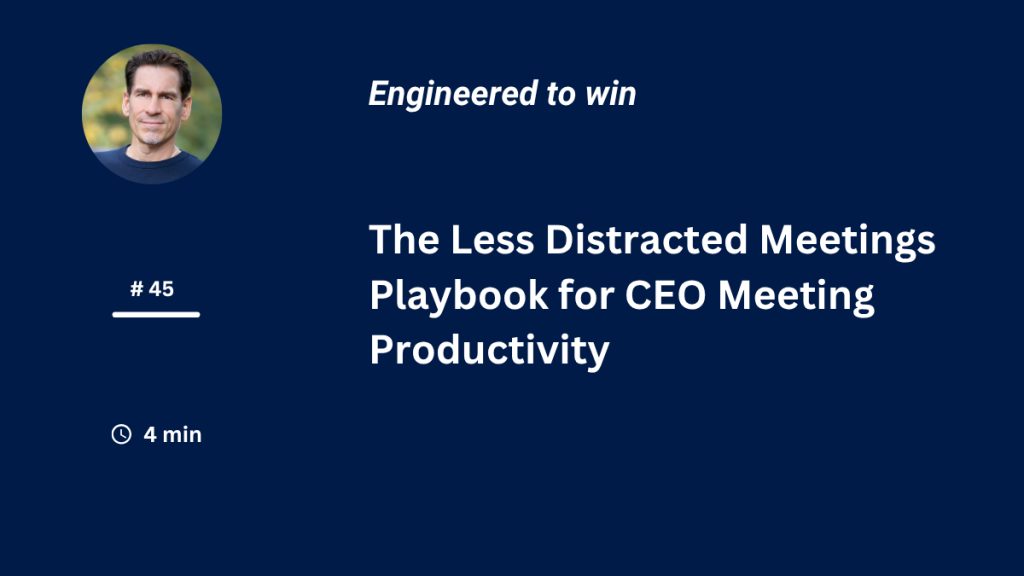How top founder-CEOs cut meeting bloat, regain focus, and make every minute count — without adding more structure or headcount
CEO meeting productivity isn’t just a scheduling issue—it’s a leverage problem.
Meetings should be the moment your team aligns, unlocks decisions, and walks out with clarity. Instead, most meetings drain energy, multiply confusion, and kill execution speed.
This mini-playbook gives you seven science-backed shifts to increase CEO meeting productivity by 30–50% in just 7 days.
No more pointless syncs. No bloat. Just smarter leadership.
You're not in too many meetings—just too many useless ones
A growing body of research shows why your meetings feel exhausting:
- Zoom fatigue is real. Studies from Stanford and MIT Sloan confirm that seeing yourself on camera, switching contexts, and multitasking on video calls burns mental energy faster than in-person meetings.
- Context switching reduces performance by up to 40%. According to Monitask, it takes your brain over 20 minutes to refocus after every shift. Now multiply that by every back-to-back call.
Related: Why 10x Growth is Easier Than 2x — a systems lens on subtraction and signal over noise.
7 Steps to Optimize CEO Meeting Productivity
1. Run an Anti-Meeting Audit
Identify the three recurring meeting types that create noise (e.g. status updates, vague syncs, and bloated check-ins).
Eliminate or compress at least 30% in one sitting.
2. Use a 1-Page Clarity Agenda
Every meeting must promise one of three outcomes:
- A decision
- Team alignment
- A clear unblock
Use the Decision–Data–Owner framework for each agenda item.
3. Follow the Rule of 3 Participation
Limit every meeting to:
- The Decider
- The Builder
- The Challenger
Replace status updates with async Loom or Notion posts.
4. Flip the Calendar Kill Switch
Ask:
“If this wasn’t already on my calendar, would I still say yes?”
If not, delete it.
Then rebuild your calendar around high-leverage priorities only.
5. Shift Ownership at the Start
Open each meeting with:
“Who owns this moving forward?”
Use the Sponsor vs. Steward model to distribute responsibility and prevent default CEO bottlenecks.
6. Set a Distraction-Free Standard
- No laptops
- No phones
- No passive observers
Begin with a 2–5 minute Silent Start. This creates clarity before conversation and removes reactive groupthink.
7. Close With a 5-Minute Exit Ritual
End every meeting with:
- “What was unclear?”
- “Who owns what?”
- “What would’ve made this meeting half as long?”
These questions embed learning and ownership into the rhythm of your team.
Try This Today: The 1-Hour Meeting Reset
Book 60 minutes this week to:
- Kill three low-leverage recurring meetings
- Rewrite a 1-page agenda using Decision–Data–Owner
- Replace one live meeting with an async Loom
- Open your next call with: “Who owns this moving forward?”
You don’t need more meeting tools. You need more intention.
What the Science Says About Cutting Meeting Bloat
MIT Sloan found that reducing on-camera time and eliminating multitasking drastically improves focus, retention, and team morale.
It’s not more structure you need—it’s fewer distractions.
Meetings without ownership feel like time theft. Meetings with clarity feel like momentum.
Where Could You Regain 10 Hours This Week?
If you want better execution, start with improving CEO meeting productivity.
Your best team members are likely drowning in updates, reacting instead of building, and wondering why they’re even in the room.
Change that with this simple mindset shift:
Every meeting must buy back time, not just spend it.
Tool of the Week: Loom + Notion
Record async updates with Loom and drop them into a shared Notion database.
Use this format for every agenda:
- Decision
- Data
- Owner
This system reduces meeting fatigue, reinforces ownership, and makes every minute count.
Tip: Turn off self-view in Zoom or Google Meet to reduce cognitive drain.
Want to test this?
Hit reply and tell me which meeting you’re killing—or forward this to a founder who’s drowning in calendar chaos.
Next week: How your nervous system is sabotaging your decision-making (and how to reset it in 3 minutes).
Let’s give your brain back.
—Dan

